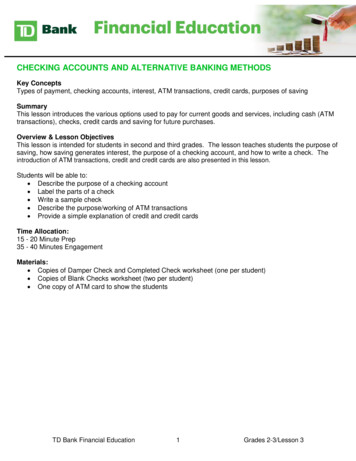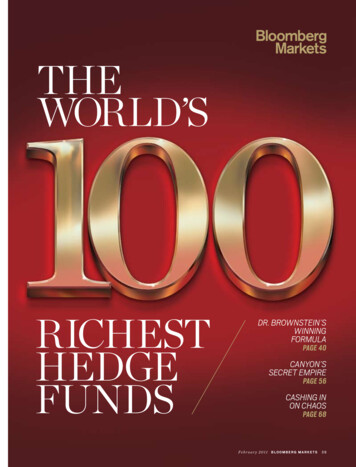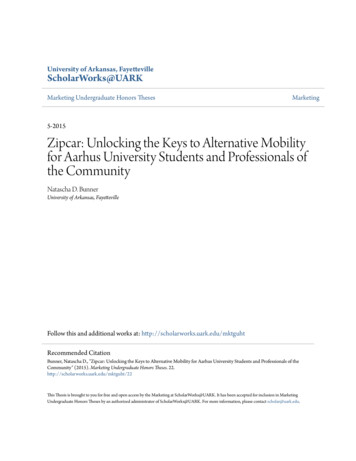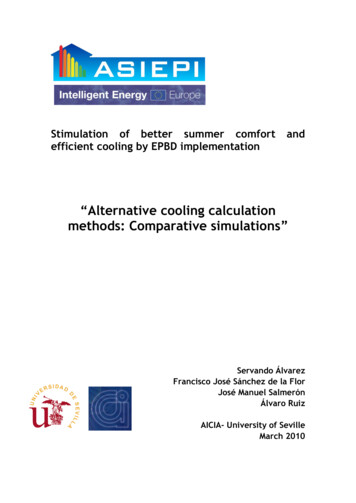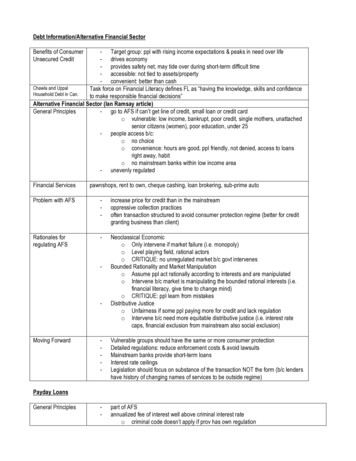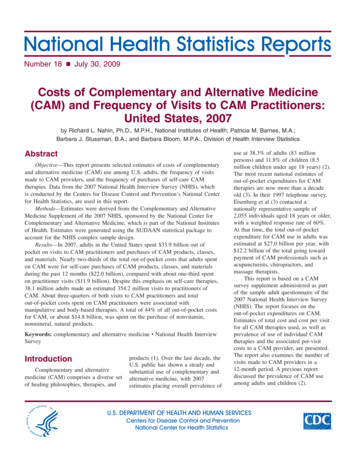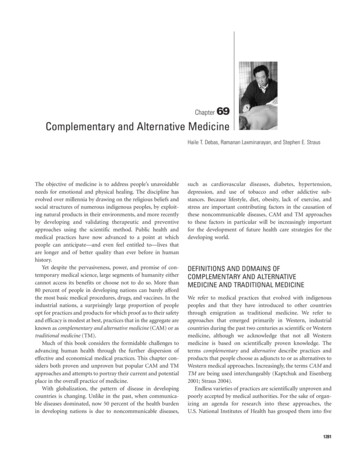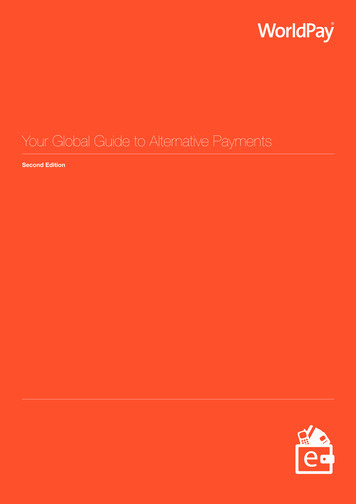
Transcription
Your Global Guide to Alternative PaymentsSecond Edition
on04Defining alternative payments05Alternative payments by type06A global overview10Global E-transaction payment mix12Alternative payment share by country14Trends and drivers21Top ten alternative payments25Alternative payments across the globe27About the data in this report713
IntroductionThe e-commerce economy isgrowing at a rapid pace with asignificant increase in globalonline transactions. WorldPay’se-commerce division reportedthat transaction volumes roseby 16% in 2013, compared to2012 across all its product groups.The value of payments processed by alternativemeans was up 21% in 2013, with turnover valueup 44%, compared to 2012. This growth meansthat customers are embracing different ways topay for goods and services: retailers and providersof services can no longer just offer credit and debitcards as a means of payment.4Defining alternative paymentsWith more than 300 alternative payment schemesin operation around the world, merchants need tounderstand which payment types to offer, and that inturn depends where their customers are and what kindof services are being offered. Given the increasinglyglobalised nature of e-commerce, a payment strategythat focuses on the needs of customers around theworld is essential to maximise transaction acceptanceand expand global reach.The WorldPay payment portfolio includes more than200 alternative payment methods. As an expert in thecomplexity of the payment landscape, WorldPay advisesmerchants on the most effective payment types to offer.This is the second edition of the Alternative PaymentsReport, which seeks to provide an in-depth view of thealternative payment landscape by volume, type, sectorand country. We hope you find it useful.www.worldpay.comThis report considers an alternativepayment to be any payment type thatis not a credit or debit card.That includes the following payment methods:Bank transfers Real-time bank transfers Offline bank transfersDirect debitsE-walletsMobileCash on deliveryOther Local card schemesPre-payPost-payE-invoicesDigital currencieswww.worldpay.com5
Alternative payments by typeBank transfersDirect debitsE-walletsMobileOnline (real-time) bank transfers offer merchantspayment with immediate online authorisation viaa customer’s bank, usually followed by next-daysettlement. Banking systems are moving towardsquicker payments.Limited mainly to low-value or recurring transactions,direct debits are not relevant to all merchants. Althoughdirect debits carry the risk of chargebacks, they arepopular with customers and merchants for regular,predictable payments such as subscriptions.Mobile payments fall into two categories, direct carrierbilling and mobile wallets.Example schemes: iDEAL, eNets andSofortuberweisung.Example schemes: SEPA, ELV (ElektronischesLastschriftverfahren Germany) and DomiciliacionBancaria (Spain).E-wallets are the fastest growing payment type aroundthe world, and are increasingly popular for purchasingdigital goods and video games because they are easyfor the customer to use. In more mature e-commerceeconomies such as the UK and US, new e-walletproducts from traditional card providers such as V.meby Visa are increasingly being accepted by merchants.Globally, Alipay and PayPal continue to dominate thee-wallet market. Growth is largely driven by youngershoppers accustomed to using e-wallets for onlinepurchases.Offline bank transfers are in most cases processedvia the customer’s online bank account. Instead ofbeing redirected during the transaction process, thecustomer is presented with a reference number, whichthe customer must then quote when they log intotheir online bank account to make a payment. Thecustomer can also choose to pay in a bank branch or viatelephone banking using the same reference number.Example schemes: Dineromail, SafetyPay and PayU2.Transactional value and share ofpayments market in US billions:2012 - 42 / 2%Example schemes: Alipay, V.me by Visa and Qiwi.Transactional value and share ofpayments market in US billions:2017 - 54 / 1%2012 - 295 / 17%2017 - 1,656 / 41%2 Please note all providers offer a breadth of services, not just offlineThe number of mobile wallet solutions have increasedin the last 12 months with a wide range of differingsolutions becoming available. Due to the infancy ofmany of these solutions, they predominantly onlyoperate in their own local country / territory with onlya very small number demonstrating a truly globalcapability.Example schemes: Boku, MoPay, Zong, Zapp, SEQR,Znap (MPayME), Pingit and PayBoxTransactional value and share ofpayments market in US billions:Transactional value and share ofpayments market in US billions:2012 - 18 / 1%2012 - 122 / 7%2017 - 117 / 3%2017 - 245 / 6%6Direct carrier billing has become an important paymentmechanism with the rise of smartphones and app storesand aligns well with the purchase of digital goods andin-app payments. The process is quick and simple andenables the shopper to remain relatively anonymous,only needing to provide their phone number to completepayment.www.worldpay.comwww.worldpay.com7
Cash on deliveryOthersPayment is taken when the goods are delivered andcollected by the courier rather than by the merchant.This method is increasingly less prevalent as it isdeclining in popularity both with merchants andcustomers.Local card schemesLocal card schemes, specific to certain markets, oftenoperate much like traditional cards, but some schemeswill be more sophisticated, for instance offering card andbank transfer options. These schemes generally requirethe shopper to be redirected to their own pages forpayment completion.Example schemes: Merchant and delivery companyspecific.Example schemes: MisterCash (Belgium), UnionPay(China), Carte Bleue (France)Transactional value and share ofpayments market in US billions:Pre-payCustomers are required to buy and add funds to a cardor voucher before starting a transaction, which meansthat these cards are usually authorised immediately.Most pre-pay products have a funding limit and somewill not allow multiple cards/vouchers to fund a singletransaction, which means that pre-pay methods are notgenerally suitable for high-value goods.2012 - 93 / 5%2017 - 93 / 2%Example schemes: Astropay, Postepay, Swiff, uKash,Neosurf, Paysafecard and Toditocash.Post-payCustomers using post-pay methods are required tosettle payment at an affiliated outlet or store aftermaking a transaction online. Businesses that acceptpost-pay methods have to be prepared for delaysbetween a transaction being made and payment being8www.worldpay.comwww.worldpay.comsettled. This payment method may not be suitable forperishable goods and time-sensitive purchases suchas travel tickets.Example schemes: Konbini, Boleto Bancário MultibancoE-invoicesE-invoices enable customers to receive goods and payafter delivery without the need for sharing sensitivecredit card or bank details. The process for customerscan be as simple as entering their email address andpostcode to make a payment, while the risk of fraudis reduced for merchants.Example schemes: Klarna, Billmelater and Afterpay.Digital currenciesDigital currencies or crypto-currencies such as Bitcoinare gaining traction. However, the barriers to entry arehigh as they require a degree of technical know-how andconfidence, and they are not backed by governments orcentral banks, nor linked to any real-world currencies.Additionally, their value can fluctuate dramatically.Example scheme: Bitcoin and Litecoin.Transactional value and share ofpayments market in US billions:2012 - 164 / 10%2017 - 209 / 5%9
A global overviewThe AmericasIn 2012, North America was the leading business-toconsumer e-commerce market, accounting for a 36%share of the e-commerce market with a turnover of 625billion. This is a card-dominated market (71%) wherealternative payment methods are used less frequently. Incomparison, Latin America, which had an e-commerceglobal share of 2% in 2012, has a more diverse range ofpayment preferences ranging from bank transfers (13%)to e-wallets (10%).102017 295 1,656Asia-Pacific has shown the fastest growth in thee-commerce market compared to other regions witha turnover of 461 billion in 2012 (27% global share)and a compound annual growth rate of 34%. 23% oftransactions were made using e-wallets in Asia Pacificand this trend is set to grow over the next five years.59% Alternativepayments* 18 117 93 93Middle East and Africawww.worldpay.com57% Cards 42 54Asia PacificThe following chart compares e-commerce transactionvalues in 2012 with predictions for 2017. Forecastsshow that transactions made using cards and e-walletsare set to increase dramatically over the next five years.Cash payments are set to stay at the same value of 93billion, and payments made via bank transfers and othermethods are expected to rise slowly by 2017.43% Alternativepayments* 122 245By 2017, alternative payments willaccount for 59% of all transactionmethodsIn 2012, Middle East and Africa had a 1% share of theglobal e-commerce market, of which the majority oftransactions were cash payments. That being said, 5%of e-commerce transactions were made with e-walletsin 2012, which shows promise for uptake of alternativepayments in this region.2012 979 1,67941% Cards59%Europe accounted for 34% of the global e-commercemarket in 2012 with a turnover of 579 billion. 41%of transactions were made using alternative paymentmethods in 2012 with e-wallets being the most popularmethod. The popularity of alternative payment methodsvaries significantly between countries – nations such asthe UK, Ireland, Denmark and Turkey are still heavy cardusers, while alternative payment methods dominate incountries including Poland, Finland, Germany and theNetherlands.20122017%Europe59%Payment transactions 2012 vs. 2017Transaction Value for Payment Methods2012 vs. 201743In 2012, the total global e-commercemarket was worth 1,713 billion andit continues to grow. Whilst traditionalpayment methods are more popularin mature markets such as theUK and the US, other regions areseeing strong growth in alternativepayments. It’s estimated thatalternative payments will accountfor 59% of all online transactionsin 2017, up from 43% in 2012.*Alternative Payments excludes international card brands. 164 209CardsMobileBank transferCash on deliveryDirect debitsOtherE-wallets*figures are in USD billionwww.worldpay.com11
GLOBALE-TRANSACTIONPAYMENTMIXAlternative payments20121%2%Bank transfer1%Direct debit7%18%CardsCash ondelivery43%13%59%8%11%OtherBank transfer5%17%5%Cash ondelivery71%US & Canada2%59%By 2017, alternative payment methods will account for59% of all transactions, an increase from 43% in 2012.E-walletsOtherE-wallets2017Direct debitEuropeCardsof global onlinetransactions weremade using e-wallets in2012, replacing that ofdebit and credit cards.4%37%By 2017 cashon deliverywill accountfor 2% ofe-transactionsAlipay and PayPal continue todominate globally as the mostprevalent e-wallet types.Direct debitCards8%23%Cash sia/PacificUS & CanadaOther14%Paper-basedinvoicesare beingdisplacedBank transferAfrica &Middle East18%by digital, guaranteed forms ofinvoice such as Klarna, BillPayand RatePay.11%Cash ondelivery47%Bank transfer29% of e-transactions madeusing non-card methodsEurope41% of e-transactions madeusing non-card methodsOther1%Cards48%0%Direct debit3%Direct debit34%5%53% of e-transactions made usingnon-card methodsCash ondelivery10%Bank transferLatin AmericaOtherCardsAsia/Pacific63% of e-transactions madeusing non-card methodsE-walletsAfrica & Middle EastCardsOther*All figures are from 2012.E-walletsCash ondeliveryBank transferDirect debit66% of e-transactions madeusing non-card methods
Alternative paymentshare by countryOver the next few pages are a series of charts showing the percentage uptake of alternative paymenttypes by region and country. The payment types covered are cards, bank transfers, direct debits,e-wallets, mobile, cash-on-delivery and ash ondeliveryMobileE-walletsDirect DebitBank edenSwitzerlandTurkeyUK15
The AmericasOtherMiddle East and Africa100%OtherCash ondeliveryCash ondeliveryMobileMobileE-wallets80%E-walletsDirect DebitDirect DebitBank transferBank omEthiopiaGhanaKenyaNigeriaSouth Africa17
Asia PacificOther100%100%80%80%60%60%40%40%20%20%Cash ondeliveryMobileE-walletsDirect DebitBank ilippinesSingaporeSouth KoreaTaiwanThailandVietnam19
Trends and driversGrowth of e-walletsLeading alternative payment methods have beengrowing at an average of 35% in recent years. Whilegrowth is spread across all payment types, e-wallets areundoubtedly the leader. In China, e-wallets account forthe largest proportion of the e-commerce market, with44% of the market there.Of the e-wallet providers, Alipay and PayPal continueto be the dominant players around the world. Alipay isthe market leader in China, with a market share of 30%,while Tenpay is the second biggest provider with 13.3%of the market. PayPal and others have a marginal marketshare in comparison.44%In China, e-wallets account forthe largest proportion of thee-commerce marketTraditional card providers are recognising the growthopportunity for e-wallets and are developing cardbased e-wallets for their own brands. For example,Visa has recently launched V.me to capitalise on thisshift. Observers expect that e-wallet technology will bemade available for mobile devices, thus increasing thepotential for providers: card-based wallets are expectedto account for 25% of the card market by 2017,according to the research.While e-wallet transactions are growing across alltypes of e-commerce industries, digital content suchas downloadable books, films and TV programmes aswell as video games are encouraging customers both toembrace and demand the ability to use e-wallets fromvendors, as they provide a seamless experience forusers.www.worldpay.comwww.worldpay.com21
The number of smartphones around the world nowexceeds 1.4 billion, with the average annual smartphoneownership growth rate at 44%. Whilst mobile has beena potential area of growth for some time, technologyhas only recently advanced enough to make mobilepayments a feasible option.The past 12 months have seen rapid growth andinnovation in mobile payments. Handset manufacturersseek to differentiate devices and payment providersare introducing compatible services. Consumers arebecoming more comfortable with making higher valuepurchases via mobile devices as the overalluser experience improves.1.4bnsmartphones are used globallyAs mobile devices have become more sophisticated, anumber of specialised mobile payment solutions haveemerged, both from independent companies as well asestablished players, who have been investing heavily todevelop user-friendly applications.E-commerce via mobile devicesM-commerce as % of e-commerce turnover 2012Emergence of specialisedmobile payments7.9%7.3%6.0% 6.0% 5.9%5.7%5.0% 5.0%4.6%4.2% 4.1%2.6% 2.5%UKGermanyTurkey Netherlands Selected markets22www.worldpay.comwww.worldpay.com23
Bank transfers are increasingly migrating from two-step,offline payments to real-time internet banking transferschemes.Bank coalitions such as iDEAL, UnionPay OnlinePayments, GiroPay, EPC, Interac Online and Bpay aregrowing rapidly and gaining market share, as are otherindependent aggregators such as Sofort Uberweisungand P24, among others. In the UK, Faster Payments, aninitiative by banks to speed up the time taken to sendpayments between accounts, is a key driver for thisactivity.2%Leading alternative payments - size and growth90%80%Ukash70%By 2017 cash on delivery will accountfor 2% of e-transactions, down from5% in 2012Digitisation of invoicesDisplacement of Cash on DeliveryServices such as Klarna, BillPay and RatePay havemade invoice-based payments easier for customers,while providing greater guarantees to merchants. Forexample, RatePay, which is particularly popular inGermany, provides customers with an open invoiceso they pay the merchant after they have receivedtheir goods. High-value goods and services, such asconsumer electronics, are increasingly being purchasedthrough invoice-based services because the customerbenefits from an extended period to pay.In some regions cash on delivery, the most traditionalof cash-based payment forms, is increasingly beingdisplaced by other forms of payment such as cards ande-wallets, while new ways of making cash paymentsare emerging to suit those without access to bankingservices.60%Estimated Growth (2012)Digitisation of bank transfersTop ten alternative 20%Invoicing is more popular in markets where fewer peopleuse credit cards, such as the Scandinavian countries.BillPay was recently acquired by British-payday loancompany, Wonga.com, potentially signalling a push intoother andex Money10%0%SmallLargeBubble size 2012 e-commerce transactions24www.worldpay.comwww.worldpay.com25
Alternative paymentsacross the globeConclusionGrowth of alternative paymentsDisplacement of cash on deliveryWhile credit and debit cards have long dominated asthe payment method of choice for online transactions,by 2017 alternative schemes will overtake cards forproducts and services purchased online, with alternativepayments accounting for 59% of all transactions.Cash on delivery will decline from 5% of the paymentsmarket in 2012 to just 2% by 2017.Significant growth trend for e-walletsMerchants will need to be prepared by ensuring they areoffering customers their preferred method of payment.These preferences vary by demographic, country ofresidence and the product or service consumers arepurchasing, which shows the importance of workingwith a payment provider with specialist knowledge.E-wallet transaction value is set to rise by 1,361 billionby 2017, comprising 41% market share.Emergence of specialised mobilepaymentsMobile payment solutions will continue to grow astechnology advances and smartphone penetration ratesrise. The value of mobile transactions will increase from 18 billion in 2012 to 117 billion by 2017.26Global diversity in preferredpayment typesDifferent payment methods prevail indifferent countries, and merchantsneed to understand local preferencesif they want to expand internationallyand maximise transaction acceptancerates when they operate abroad.Country profilesThe next section of this report examines the paymenttrends in each market and the penetration levels ofpayment methods by type.Subsequent editions of this report will explorealternative payments in specific verticals andregions in greater detail.www.worldpay.comwww.worldpay.com27
AustraliaAustriaMarket summaryMarket summaryAustralia has seen sharp growth in e-commerce, with turnover rising 43.9% in 2010. However, the global recession meant thatgrowth declined to 27.8% in both 2011 and 2012, although e-commerce turnover as a proportion of gross domestic product hascontinued to rise: it was 3.1% in 2012, up from 2.9% the year before.A number of payment methods are used by Austrians, with cards the dominant but not the majority choice: 34.5% of transactionsare completed using cards. Bank transfers (31.1%) are also popular, and most of those are done online in real time (25.2%).Australians pay for e-commerce goods and services via the banking sector: cards account for 53.4% of transactions, w
The WorldPay payment portfolio includes more than 200 alternative payment methods. As an expert in the complexity of the payment landscape, WorldPay advises merchants on the most effective payment types to offer. This is the second edition of the Alternative Payments

